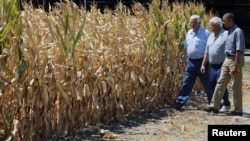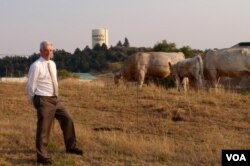MOSCOW, IDAHO —
The people who raise the cattle destined to become steak or hamburger on Americas’ dinner plates are feeling a serious financial pinch.
Recent wildfires scorched more than a million hectares of North American rangeland. In addition, a continuing drought in the American heartland is driving up the cost of hay, grains and other basic livestock feed.
Now, ranches and feedlots are looking to cut their feed costs in the short term while working to make the cattle more efficient in the long run.
Big expense
The cost of animal feed is by far the biggest expense on the ledgers of most beef farmers. Over the past several months, prices for a variety of feeds - led by corn, or maize - have flirted with record highs.
In the northwestern state of Washington, cattleman Jack Field is going to great lengths to postpone or avoid buying hay at current sky-high prices. It's so expensive, he's made plans to truck his small herd halfway across the state -more than 300 kilometers- then move them again later, to graze on crop stubble.
"The transportation is a little bit of a pain," Field says. "It is expensive, but by moving cattle around, if I can keep from having to feed hay, I can make that pencil-and-profit in my situation."
Fortunately for Field, none of the land he rented has been scorched by wildfires. But others are not so lucky. It's been a bad fire year in the USA.
Search for alternatives
Oregon State University beef scientist Tim DelCurto is working with ranchers and feedlot owners to analyze alternatives.
He says there are plenty of options for lower-cost feed, including grass-seed straw, distillers grains left over from ethanol fuel production, cannery waste and vegetable processing byproducts such as misshapen green beans, carrots and yes, even French fries.
"I think one of the unique attributes of beef cattle, and sheep fit this, too, unique attributes of ruminant animals is that they can digest virtually anything," DelCurto says.
He's in high demand as a guest speaker at seminars this autumn, offering cost-saving tips to cattle ranchers. The focus is on short-term solutions, but there’s plenty of interest in longer-term strategies, too.
Looking ahead
Agricultural research universities have taken note of the rising cost of fodder, and many are giving greater attention to an issue that experts call "feed efficiency."
In a cattle barn at the University of Idaho, physiology professor Rod Hill points out sensors and electronic gates on feed bins. They allow him to track exactly how much food each cow eats.
Periodically, the cows also have to be coaxed onto a scale to calculate how efficiently each is converting fodder into meat, fat, bone and hide. Hill says the variation within a herd might surprise you.
"These animals, [to] your eye and mine, they look quite homogenous," Hill says. "But the variation in intake for animals growing at the same rate is of the order of thirty-five percent."
This is a case where cows and people have something in common.
"We talk to people who say, 'All I have to do is look at the candy store and I put on three pounds.' We don't actually quantify it quite so precisely in humans, but we know in humans that some people can eat a little and they put on quite a bit of weight and some people can eat a lot and hardly put on any weight. It's a biological phenomenon."
Selective breeding
A newly published animal science book that Hill edited explains how ranchers can use selective breeding to achieve the same growth with less feed or less environmental impact on rangeland. But he warns there is risk in focusing too much on one trait.
"Less efficient animals are slightly fatter. More efficient animals are slightly leaner. We wouldn't want to just go after efficiency and then forget about body composition. We wouldn't want animals to become too lean. That might reduce marbling in the product, especially in the quality cuts where the profit is."
In the not-too-distant future, Hill expects bulls at auction to carry a score for efficiency.
But that performance measure isn't widely available or standardized just yet. In the meantime, numerous ranchers - especially in the American Midwest - are thinning their herds to control costs.
A consequence is that starting next year, beef will be in tighter supply, and domestic and export customers can expect to pay higher prices.
Recent wildfires scorched more than a million hectares of North American rangeland. In addition, a continuing drought in the American heartland is driving up the cost of hay, grains and other basic livestock feed.
Now, ranches and feedlots are looking to cut their feed costs in the short term while working to make the cattle more efficient in the long run.
Big expense
The cost of animal feed is by far the biggest expense on the ledgers of most beef farmers. Over the past several months, prices for a variety of feeds - led by corn, or maize - have flirted with record highs.
In the northwestern state of Washington, cattleman Jack Field is going to great lengths to postpone or avoid buying hay at current sky-high prices. It's so expensive, he's made plans to truck his small herd halfway across the state -more than 300 kilometers- then move them again later, to graze on crop stubble.
"The transportation is a little bit of a pain," Field says. "It is expensive, but by moving cattle around, if I can keep from having to feed hay, I can make that pencil-and-profit in my situation."
Fortunately for Field, none of the land he rented has been scorched by wildfires. But others are not so lucky. It's been a bad fire year in the USA.
Search for alternatives
Oregon State University beef scientist Tim DelCurto is working with ranchers and feedlot owners to analyze alternatives.
He says there are plenty of options for lower-cost feed, including grass-seed straw, distillers grains left over from ethanol fuel production, cannery waste and vegetable processing byproducts such as misshapen green beans, carrots and yes, even French fries.
"I think one of the unique attributes of beef cattle, and sheep fit this, too, unique attributes of ruminant animals is that they can digest virtually anything," DelCurto says.
He's in high demand as a guest speaker at seminars this autumn, offering cost-saving tips to cattle ranchers. The focus is on short-term solutions, but there’s plenty of interest in longer-term strategies, too.
Looking ahead
Agricultural research universities have taken note of the rising cost of fodder, and many are giving greater attention to an issue that experts call "feed efficiency."
In a cattle barn at the University of Idaho, physiology professor Rod Hill points out sensors and electronic gates on feed bins. They allow him to track exactly how much food each cow eats.
Periodically, the cows also have to be coaxed onto a scale to calculate how efficiently each is converting fodder into meat, fat, bone and hide. Hill says the variation within a herd might surprise you.
"These animals, [to] your eye and mine, they look quite homogenous," Hill says. "But the variation in intake for animals growing at the same rate is of the order of thirty-five percent."
This is a case where cows and people have something in common.
"We talk to people who say, 'All I have to do is look at the candy store and I put on three pounds.' We don't actually quantify it quite so precisely in humans, but we know in humans that some people can eat a little and they put on quite a bit of weight and some people can eat a lot and hardly put on any weight. It's a biological phenomenon."
Selective breeding
A newly published animal science book that Hill edited explains how ranchers can use selective breeding to achieve the same growth with less feed or less environmental impact on rangeland. But he warns there is risk in focusing too much on one trait.
"Less efficient animals are slightly fatter. More efficient animals are slightly leaner. We wouldn't want to just go after efficiency and then forget about body composition. We wouldn't want animals to become too lean. That might reduce marbling in the product, especially in the quality cuts where the profit is."
In the not-too-distant future, Hill expects bulls at auction to carry a score for efficiency.
But that performance measure isn't widely available or standardized just yet. In the meantime, numerous ranchers - especially in the American Midwest - are thinning their herds to control costs.
A consequence is that starting next year, beef will be in tighter supply, and domestic and export customers can expect to pay higher prices.






